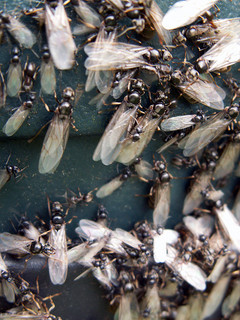You would want to be living under a rock not to have seen them! Last week I was literally covered in them during an evening stroll; then it seems the infestation spread… yesterday it arrived in Dublin! Seagull invasions are so last week… we are all talking “flying ants”.

Ants with wings is this something new?
Not really. There is no one species of winged ants but many species will produce wings during a certain stage of the life cycle of the colony. As we all know, ants like to be busy so if all the chores are done, the larder is full, the young are being tended to and the queen is happy, well there is really only one job left to do…. procreate!
And it is a lot easier to get out there and find the right ant for you if you can grow a pair of wings for a while!
To put it a little more scientifically… in mature, thriving colonies, some eggs, treated under the right conditions, will produce winged ants, both male and female. The females are virgin queens with the potential to start a new colony of their own. The males, well, they have only one thing on their mind!
Why so many?
The newly produced winged ants will remain in the colony until conditions are right for what is referred to as the Nuptial flight. These flights are very weather dependant, requiring warm temperatures with little chance of strong wind or rain. The ants will all leave the colony together in one coordinated flight. This is also synchronised with the flight of ants for neighbouring colonies.
The large numbers serve two purposes….
- firstly, they increase the chances of a significant number of ants surviving predation and successfully mating and starting new colonies
- secondly, where reproduction is concerned, it is always a good idea to widen the gene pool. The large swarms of flying ants from many different colonies allows cross breeding and the creation of a stronger genetic line.
What happens to the winged ants after the “deed is done”?
After mating both the male and female ants loose their wings.
The female will often mate with several males during the mating process but this will be the only time in her life that she will mate. She stores the male sperm in a pouch in her body called the spermatheca. After mating she will dig a nest to start her own colony… the sex on her offspring is decided by her. All fertilised eggs are female, all non fertilised eggs are male.
When she starts a colony she will produce only female ants, each of which will be infertile and wingless.The queen tends to the first set of eggs on her own but once the worker ants are reared they will tend to her every need and the needs of the colony.
The males? Well they actually die soon after mating… it is their sole purpose.. tough job but what a noble one!